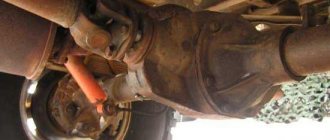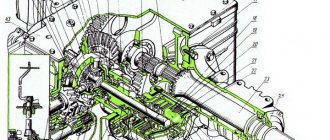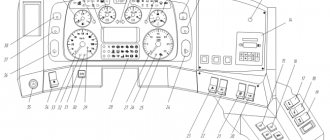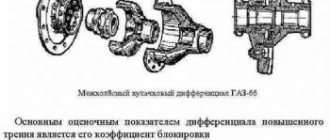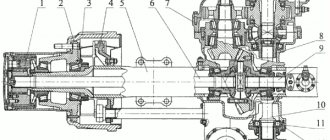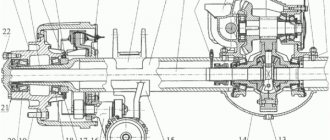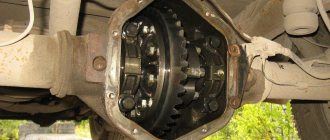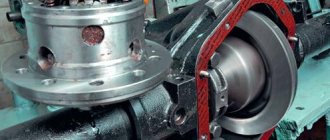Differential locking is an additional design solution that allows you to compensate for its main disadvantages. If on a dry, flat road the differential provides safe maneuvering and comfort, then when driving on rough terrain or while driving on a slippery road surface, it can completely deprive the car of the ability to move. To prevent this from happening, it is necessary to limit the functionality of the node or completely disable it for a while. But differential locking methods are so diverse that we need to consider the main ones separately.
Explanation of operating principle
Translated from Latin, differentia means “difference.” In a car, a differential is a mechanism that distributes torque to the car axles. It definitely exists in every car. A simple differential is called classic, open or free.
Let's imagine that the rear axle gearbox does not have a differential, but there is a single axle, like a tricycle.
Since there is no absolutely linear movement, and the driver's hands almost never lie motionless on the steering wheel, it is clear that the path of the drive wheels will be very similar, but slightly different.
If there were no differential, then the path of the left and right wheels would be the same. Then constant slipping will become inevitable, since a common trajectory is “imposed” on the wheels. This results in increased tire wear and rapid failure of transmission units.
The task of the gearbox is to give the wheels independence and “freedom”, to separate their rigid connection.
How does a classic differential work?
If there is one drive axle (all VAZ classics), then one gearbox is required between the rear wheels, i.e. interwheel. In the case of a full-fledged jeep, there are as many as three differentials - two inter-wheel differentials for each axle, and an additional inter-axle one.
This mechanism (also called a gearbox) is installed in the rear axle housing. The drive gear transmits torque to the driven gear. It is distributed into two gears of the axle shafts, and they rotate the wheels.
Additional gears - satellites are a symmetrical equal-arm lever, and transmit forces equally to the wheels.
When the car moves in a straight line, the satellites do not rotate. As soon as the car slides onto uneven ground or enters a turn, that is, when each wheel has its own path, the satellites begin to rotate and redistribute the torque between the wheels of the drive axle, and to the axle shaft that has less resistance and is easier to spin.
The VAZ differential is shown in the figure below:
8 — axle gear; 9 — satellite; 11 — driven gear of the main gear; 18 — drive gear of the main gear;
This is how the satellites behave and distribute the moment of movement in different areas:
- straight movement - turn left - the right wheel slips
From the analysis of the rotational speeds of the axle shafts and gearbox it follows that:
- If one wheel is stationary, then the free wheel rotates “for two”, and the rotation speed is doubled.
- If one wheel slips, it spins faster and starts to slip, and the second wheel with good grip will receive the same torque, since it is distributed equally, and the differential cannot give it all the traction.
- If the traction of a single wheel becomes less than the resistance to movement, the car will stop.
- In this case, the situation of point 1 arises, the running wheel stops, and the previously slipping wheel sharply increases speed.
- When you try to “add gas,” the speed of the slipping wheel increases.
So, a conventional gearbox does not help the drive axle on slippery roads and on surfaces with high rolling resistance (snow, sand and mud). The cost of a conventional gearbox is about 5,000 rubles.
Complete blocking 100% and partial
A 100% block is called complete. In other words, it is a complete coupling that helps transfer the torque completely to the axle with the best grip. When driving on bad roads, this type of locking is the most optimal. This type of locking hardly does its job, but is simply a clutch. Full blocking is performed manually by the car owner himself, but it is still not recommended, since the engine becomes heavily loaded. In addition, gearboxes and tires with transmission are subject to rapid wear. All this negatively affects their condition.
As for partial blocking, it works in the same way as hard blocking. However, it produces a KM transmission where you feel not full clutch, but a specific percentage. Partial blocking mechanisms operate in automatic mode or using forced activation.
About forced blocking
If the car often goes off-road and is used in winter and during the mud season, installing a forced locking of the cross-axle differential helps. In this case, the rotation of the satellites stops. In this case, the wheels lose all independence and rotate exactly the same in all situations. This is a so-called self-locking gearbox.
The downside is increased fuel consumption and increased tire wear. Therefore, after overcoming a difficult section, you need to turn off the lock. In some designs, it is possible to automatically unlock when the speed increases, or, conversely, it is possible to enable the locking only at low speed.
In order to simplify the control process, there is a self-locking gearbox.
Claw clutch mechanism
The locking device mechanisms described above may seem quite complex. However, almost all of them began their journey precisely with this classical mechanism, or rather, with the tandem “ cam clutch – drive ”. Over time, this tandem has changed greatly, with both new types of drives appearing and claw couplings being seriously modified.
In short, a jaw clutch is a pair of coupling halves that are located at the ends of coaxial shafts. In their normal position, the coupling halves are open . At the ends of the coupling halves there are so-called couplings located in a circle. rectangular or trapezoidal profile cams. If it is necessary to block the shaft, the coupling halves are rigidly engaged - they move and fill the spaces between the cams of the opposing half-coupling - ensuring the transmission of torque from one shaft to another. As you might guess, the moment of engagement of the coupling halves is accompanied by an impact. For this reason, they are equipped with special damping inserts. The mechanism itself can be driven by one of the following drives:
- Electric;
- Mechanical (increasingly rare);
- Pneumatic;
- Hydraulic.
electric drives are becoming more common today . It's not only about its high reliability, but also about its convenience. The locking mechanism can be activated by pressing just one button on the vehicle's dashboard. If the control is completely manual and excludes electrics, then it almost certainly requires manipulation of the lever mechanism. The latter drives hydraulics or pneumatics, which then locks the differential by closing the cam clutch.
Types of forced blocking
Let’s make it clear right away that we are not considering barbaric options like welding satellites on the “native” differential. Also, the partial option of establishing “preload” is not considered.
- Increased friction disc locking. Friction clutches are installed. When the wheels begin to experience different resistance, the friction inside the clutch increases and locking occurs. Locking with discs requires adjustment due to their wear and the use of special gear oil.
- Viscous coupling blocking (viscous coupling). Its principle is similar to a disk clutch, but a hydraulic clutch has many sticky disks (Fig. 7). The discs are immersed in a special viscous liquid. The basis of this liquid is silicone, which hardens when heated. When the rotation of one axle shaft is ahead of the other, heating occurs, solidification of the liquid and rigid engagement of the disks occurs. This type of blocking begins to work softly at first, then as it hardens, the effect increases sharply, and lasts until the axle shafts begin to work evenly, then, along with cooling, the gel liquefies. The big plus is the lack of maintenance. A necessary condition for long-term operation is complete tightness. Such viscous couplings are installed on “parquet” city SUVs. On severe off-road conditions they work poorly and overheat.
- Self-locking helical worm gearbox. Reliable option. When moving in a straight line, the worm-shaped screws rotate freely in the housing (Fig. 8). When the nature of movement changes, the screws move to their extreme positions and are fixed in the grooves. In this case, the blocking is triggered. The response time depends on the screw profile. When the torque is equalized, the screws again protrude from the grooves into free rotation. The advantage is low wear, the service life is equal to the life of the “native” differential. In addition, no special oil is required, just regular transmission oil. The cost of a screw lock on a VAZ 2107 is about 10–13 thousand rubles.
- Planetary differential locking mechanism (DAK), or Krasnikov scheme (Fig. 9). This mechanism uses a classic differential circuit, but instead of satellites, chains of balls work. This differential is locked not due to the difference between the load on the wheels, but when a change occurs between the axle load and engine traction. The cost of installation on a VAZ 2107 is about 10,000 rubles.
Label cloud
April 2010
| Mon | W | Wed | Thu | Fri | Sat | Sun |
| « Mar | May " | |||||
| 1 | 2 | 3 | 4 | |||
| 5 | 6 | 7 | 8 | 9 | 10 | 11 |
| 12 | 13 | 14 | 15 | 16 | 17 | 18 |
| 19 | 20 | 21 | 22 | 23 | 24 | 25 |
| 26 | 27 | 28 | 29 | 30 | ||
Pros and cons of installing a self-locking gearbox
So, when installing a self-locking differential, you purchase:
- increased wheel traction on drive axles;
- increased cross-country ability off asphalt road surfaces;
- improved acceleration dynamics;
- improved cornering.
The price to pay for the installation is deterioration in handling (for a rear-wheel drive VAZ):
- it is difficult to hold the car when accelerating on a straight line;
- when turning, the “classic” has an increased tendency to skid;
- With any design, additional high-friction links appear, which increases, even slightly, wear and fuel consumption.
More information about electronic locking
Let us immediately note that the electronic differential lock is not essentially a lock - it is just an imitation of it. This system works in tandem with the car's ABS and is called Traction Control or EDS . The first car with an electronic differential lock was the Lexus LS400, released in 1989. The system hasn't changed much since then. It provides for the following elements:
- Wheel rotation sensors;
- Electronic control unit.
It is worth noting the following here: unlike the above locking mechanisms, the electronic system can give a command to create pressure in the automobile brake system . It has return flow pumps, as well as a pair of valves in the ABS hydraulic block. The operation of the system can be divided into 3 phases:
- Pressure increase phase:
- Temporary pressure holding phase;
- Rapid pressure release phase.
As the reader probably guessed, the start and end times of the phases will depend on the presence and degree of wheel slip. However, do not think that electronic locking excludes the use of conventional differential lock systems. On the contrary, all-terrain vehicles are in dire need of additional systems for controlling the torque that the wheels receive. The incredible cross-country ability of the latest generations of 4Runner and Prado cars from the Japanese concern Toyota is due to the addition of an electronic “assistant” to the existing T-3 .
Differential purpose
When turning a car, wheels located closer to the center of curvature of the trajectory travel a shorter distance than those rotating in an outer arc.
Their speeds are also different. And since a drive without a differential rotates both wheels of the same axle at the same speed, one of them begins to slip. This increases tread wear and worsens vehicle handling. The differential allows the drive wheels to rotate at different speeds. As long as the drive axle is in good contact with the road, this device works flawlessly. But as soon as the road grip under one of the wheels deteriorates, for example, when it hits ice or liquid mud, only one of them will rotate. A wheel with a high coefficient of adhesion stops spinning and the car stops. If you lock the differential, this will not happen. Therefore, a locked differential improves the vehicle's maneuverability on difficult sections of the road.
If a car has one drive axle, then it also has one differential - between the wheels of this axle. A car with permanent 4-wheel drive has three. One between the wheels of each axle plus one between the axles.
Device
The operating principle of the above-mentioned unit is the same, no matter where it is installed. The classic car differential is based on a planetary gear. The cardan shaft rotates the drive gear of the axle reducer. Its rotation is transmitted to the driven gear. And since it is attached to the differential housing, it moves with it. From the body, the torque is transmitted to the axle shafts using gears independent from each other, called satellites. The rotation speed of the propeller shaft is not equally divided between the axle shafts. However, for any ratio of speeds, their sum is always constant.
- automatic;
- forced, activated by the driver.
By blocking control method:
- mechanical;
- electromechanical;
- hydraulic;
- pneumatic
Automatic differential lock
A self-locking differential is a mechanism that, under certain conditions, switches and, turning into a direct transmission, begins to divide the rotation speed of the driveshaft between the axle shafts equally. Differentials with automatic locking can lock themselves depending on the value of one of two parameters:
- differences in angular velocities of the axle shafts. This group includes differentials with disc locking, cam, viscous coupling and operating according to the Ferguson formula;
- torque transmitted to the axle shafts.
Preload locks
Preload clutch, why it is needed and how it works:
Due to the operation of any screw-type or cam-type cross-axle self-locking differential, short-term peak loads appear in the vehicle transmission, which contribute to increased wear of transmission parts. When the “self-locking” system operates on the front axle of the car, an additional push force can be created on the steering wheel, which requires special care and skills of the driver and sharply reduces the car’s handling characteristics for a short time.
The preload clutch connects the axle shafts with a certain force, specified by the preload value. When the force is exceeded, the axle shafts rotate relative to each other and the mechanism works like a regular screw lock. The preload clutch provides the following advantages relative to a conventional “self-block”: - eliminates the occurrence of peak loads in the vehicle transmission and on the steering wheel; — promotes earlier activation of the lock in driving conditions that require increased vehicle cross-country ability; — in the complete absence of torque on one rotating wheel, it allows the second stationary wheel of the same axis to be reliably put into operation (the situation of starting a car in conditions of diagonal hanging or when hanging one wheel of the drive axle). Recommended preload values: For cars used in everyday use, the recommended preload is from 4.0 kg to 7.0 kg in the rear axle. It is recommended to place no more than 7 kg on the front axle.
For sports cars, the recommended preload is 5-6 kg on the front axle and 8-10 kg on the rear.
How the differential works and how it should work
In no way do I want to offend the best feelings of those who perfectly completed a two-week driving course and received a license, but we will allow ourselves to remind you of what a differential is and what it does on the drive axle. Let us remind you simply because sometimes quite revealing incidents happen that speak more than eloquently about the technical competence of drivers. For example, when a taxi driver with 30 years of experience was shown that the rear wheels of his GAZ 24, hung on a lift, were spinning in different directions, he began drinking valerian back in the TO2 mechanic shop. It was a revolution in consciousness for a man who spent half his life behind the wheel and did not know how a basic mechanism worked. It is for this reason that we allow ourselves to steal a few minutes of attention to briefly familiarize ourselves with the operation of the automobile differential of the drive wheels.
Initially, the car did not have any differential. This is where the precariousness of the question lies. There was no need to lock the wheels, since they sat on one solid axle and rotated at exactly the same speed. Later, when the first cars learned to turn and accelerate sanely, they began to notice that when turning, the wheels travel different distances, according to the turning radius. This entailed disgusting handling, instant tire wear and enormous loads on the car’s still primitive transmission. Then the rear axle was cut in half, a bevel gear was welded to each of the axles, and two more bevel gears were placed between them, meshing with the axle gears. Thus, the wheels gained complete independence from each other. That is, when the car moves in a turn, the wheels can easily rotate at different angular speeds, which is what the engineers of that time achieved.
But not even a few decades have passed since the impeccable and seemingly ideal design of the drive axle differential turned into its main drawback, which, by the way, is still being fought against. The difficulty is that when driving on dry and smooth asphalt, the drive wheels behave perfectly - they turn at different angular speeds, but on a straight section of the highway they receive the same torque from the engine. But as soon as one wheel hangs in the air, the car will helplessly rotate with the free wheel, while the second one simply stops. And there is no escape from this situation other than full or partial differential locking. Engineers have been thinking about how to lock wheels for more than 50 years. But their work was not in vain, because there are already several types of blocking, and this is what we know about them.
How to set preload
Preload adjustment is carried out by installing a package of special spring washers that push the gears inside the lock. A complete package of such special washers, when folded together, is 1 cm thick, but all the washers are different in thickness so that you can adjust the differential preload moment.
To adjust the preload you will need:
- pointer torque wrench (a wrench with clicks is not suitable, it will take a long time to set up);
- a homemade special part made from a simple internal grenade (cut off and a bolt welded to it) - see the video below;
- set of spring washers (rings);
Procedure for adjusting preload:
- Disassemble the locking differential (remember the sequence). After removing the cover, pull out the axle shaft auger gear; behind it comes a narrow gear with a large internal hole, but which has a side; then come those same adjusting spring washers. You can pull out the screw satellites (the preloads themselves) to check how much wear they have.
- Install new washers.
- Collect.
- Using a torque wrench and a special homemade part, we determine the tightening torque. When the key begins to turn, at this moment the arrow shows the tension torque.
This video discusses the option of adjusting the locking washers of a VAZ 2108 car.
A preload of up to 5 kg does not flatten the washer to a flat state; such a tension moment is considered a resource tension. Locking with a tension of up to 5 kg will help not significantly lose its characteristics for about 4 years. Any blocking with tension in the first couple of months loses about 1 kg of tension.
Experts recommend making a preload of no more than 5 kg for a self-locking front differential, and no more than 7 kg for a rear differential. At a maximum differential preload of, for example, 9 kg, all spring washers will already be pressed and the effect of the springs will be lost.
Do-it-yourself differential lock
It can even be logically assumed that blocking a node can be either complete or partial. Full locking ensures that the torque will be transferred entirely to the wheel that has better traction. In this case, all differential elements are rigidly connected. Partial locking simply limits the transfer of torque between the two wheels, redirecting it in favor of the wheel with more grip. If we take an interest in the gear ratios in more detail, then for a free, simple mechanism, the blocking coefficient is taken as one. In mechanisms with locking, this coefficient should not exceed 5, since such an increase can cause destruction of the clutch and drive axle gearbox.
Now it’s worth taking a look back towards real life. Yes, we will talk about locking systems, about their advantage over a free differential, but willy-nilly the question of the applicability of all this technology to modern domestic cars comes up. If you take a quick look at those cars that desperately need differential locking, SUVs, Gazelles, and even crossovers, then in reality it will turn out that we don’t even produce cross-axle differentials with locking. For a hundred years, UAZ has been plowing taiga ruts only with a center differential with forced locking, made according to the scheme of military trucks ZIL 131, GAZ 66, KrAZ. A bestseller of the last forty years among hunters and fishermen, the Niva, and after the Niva Chevrolet, also has only a center differential with a hard lock, made in the United States. Poor loaded Gazelles skid already with medium load on wet grass, and there’s nothing to say about snow.
There are handicraft companies that sell self-locking differentials for VAZ 2101-2107, and for the front-wheel drive VAZ Baroque, for Kalina, Priora, tens and eights. The price of such a self-block is around 8 thousand rubles, and for installation they will charge another 8-10 thousand, since in the case of installation on front-wheel drive cars it can take a day or even two. The best option that can be bought for VAZs is a self-locking friction differential from the Tolyatti company Val-Racing. They also make self-locking differentials for UAZ Patriot, Niva, and foreign cars, but the price is completely different - from 20 thousand rubles. The device is well designed, has a blocking coefficient from 3 to 5 depending on the modification and, yes, it works. But there is no need to talk about serial large-scale production yet. But you can install it on any car with your own hands and get, albeit the most primitive, but working lock.
How to lock the differential
Difference in operating principles
Often all-wheel drive vehicles have three types of structures at the same time: one center differential and two axles. For high-quality work, both full and partial automatic or manual interaxle blocking can be used.
Already, many vehicles have begun to use all kinds of electronic control systems for vehicle movement. The advantage of electronic locking is higher cornering traction and the ability to adjust the degree of locking depending on the driver's preferences. The only drawback is that such a differential is insensitive to rapidly changing road conditions.
Forced differential lock
This is a primitive tractor locking system, which is produced using a dog clutch. It is responsible for the rigid connection of the mechanism body with one of the axle shafts. The most advanced forced locking systems in Jeep Wrangler, Toyota Land Cruiser, and Suzuki Vitara cars of previous years could have either a mechanical drive or a pneumatic or electro-hydraulic drive. By the way, the MTZ 80 tractor has such a system with hydraulic drive. The disadvantages of this locking design are that it cannot be used in normal conditions, and the system is only activated when off-road. This is quite normal for SUVs; it couldn’t even be any other way. But any instruction manual will tell you that after passing a difficult section, the system must be deactivated, since otherwise it could damage the transmission.
Automatic or manual?
Having understood in more detail the principle of operation of the differential lock, drivers wonder whether it is useful in operation. Yes, it is really useful, but it has different types. All of them are described above.
As for the main types of blocking, it can be automatic and manual. Automatic is a complete shutdown of the differential, and manual is just a limitation of functions.
Manual locking is the simplest way to disengage the differential and occurs by pressing the switch and activating the limiter assembly. It is this that prevents the force from being distributed between the wheels. The advantages of the manual block include the operation of the differential in normal mode with the limiter turned off. Also, the car owner is able to independently decide when he needs a lock and when not.
The negative aspects of control include the fact that operation of the switch distracts the driver from driving. This process usually occurs when driving in difficult conditions. And in order not to break the differential through negligence, the driver should turn it off in a timely manner. Before choosing the type of lock, the driver will need to install the limiter, the mechanism for its operation, and the button as well.
If you compare manual locking with automatic locking, you can identify several features. As long as the driver's foot is on the gas pedal, the lock remains active, adapting to driving. This means that the main advantage of auto-locking is that it is already enabled in “difficult conditions”. The driver will not have to be distracted and take his hands off the steering wheel. Also, compared to the manual type, the automatic lock is easy to install.
The main disadvantages of the auto unit include continuous operation, which manifests itself in the resistance to turning the steering wheel, as well as the sound in the tires.
It is quite difficult to answer the question which types of differential locks are better. The point is that the best type depends on the vehicle itself.
Self-locking differential
This is a cross between the simplest hard locking system and a free differential. The simplest self-locking differential is a disc. It is the same free mechanism, but with friction discs on each axle shaft, operating like a clutch. This mechanism is good because it allows you to regulate the pressing force of the clutches, and as a result, the distribution of torque between the drive wheels. The pressing force can be either fixed or adjustable by a pneumatic drive, hydraulics or electronics. Such differentials are used in sports car axles and as center differentials in some SUVs, the previous generation Nissan Patrol, for example.
A viscous coupling, or viscous coupling, is a kind of torque converter. This is a set of disks that are located close to each other and are located in one housing filled with silicone liquid. This liquid tends to harden as the temperature increases, which is what happens when some disks begin to rotate faster and others slower. As soon as the wheels begin to equalize angular speeds, the fluid cools and the viscous coupling is unblocked.
Video: differential lock
There are also electronic differential locking systems, but in fact, this is just an imitation, since the brakes act as a mechanism compensating angular speeds, not the transmission, and the system is triggered by a signal from sensors. There are quite a few of these systems, but the most famous are EDS in most cars (Nissan Pathfinder, Renault Duster), or the ETS system in Mercedes cars. Volkswagen installs more advanced systems, ETS with advanced functions, XDS. These complexes are installed on Skoda Octavia, Volkswagen Passat, Tiguan. Electronic systems cannot be considered as differential locks, but only as means of increasing safety.
Selection table for VAL-RACING differential by preload.
Class information.
STANDARD (civilian) - Use of a car in urban conditions with trips to the countryside, country house, etc. Active use in winter conditions. Mileage up to 30% off-road.
TOURISM - Use of a car for commercial purposes and active recreation (repair departments, environmental services, Ministry of Emergency Situations, foresters, rural medicine, hunters, fishermen, tourists, etc.).
Up to 70% off-road. Budget option for Niva and UAZ. One blocking is installed on the rear axle with a blocking coefficient of 0.7.
SPORT - Participation in sports competitions.
To participate in motorsport events such as rallycross, rally or sprint racing, it is advisable to install a disc lock on front-wheel drive cars.
| Make, model of car. | Standard | Tourism | Sport | |||
| Front axle | Rear axle | Front axle | Rear axle | Front axle | Rear axle | |
| VAZ 2101-2107 | Type A, PN 4.5-6 kg/m | Type A, PN 5-7 kg/m | Type M, PN up to 10 kg/m | |||
| LADA 4×4, Chevrolet NIVA | Type A, PN 4.5-6 kg/m | Type B, PN 5-6 kg/m | Type A, PN up to 10 kg/m | Type B, PN 5-7 kg/m | Type M, PN up to 10 kg/m | |
| VAZ 2108-21099, LADA Samara, 110, Priora, Kalina, Granta* | Type C, PN 3.5-5 kg/m | Type C, PN 4.5-6 kg/m | Type C, PN up to 10 kg/m | |||
| UAZ "Spicer" | Type J, PN 4.5-6 kg/m | Type J, PN 4.5-5.5 kg/m | Type J, PN 6-8 kg/m | Type N, PN 5-7 kg/m | Type N, PN 10 kg/m* | |
| Gazelle, Sable | Type L, PN 4.5-6 kg/m | Type L, PN up to 10 kg/m | ||||
| UAZ "Reductorny" | Type I, PN 4.5-6 kg/m | Type I, PN 4.5-5.5 kg/m | Type I, PN 6-8 kg/m | Type O, PN 5-7 kg/m | Type O, PN 10 kg/m* | |
Type A, C, B, J, I - correspond to certain car brands and blocking coefficients up to 50% or 0.5.
Type M,N,O - UCB (increased blocking coefficient) correspond to certain brands of cars and blocking coefficient up to 70% or 0.7.
Disc locking coefficient up to 90%, with the ability to configure “Start”, “Brake” and “Universal”.
PN - preload.
* ATTENTION! The tension after 8.5 kg/m can work with some characteristic noise. Exhibited only at the request of the client in the sports category. Noise at high tension is not a warranty defect.
Can every car have a locked differential?
Differential locks are usually used for sports cars or SUVs. Particularly in the case of SUVs, locking differentials are already installed during vehicle assembly. Although a differential lock is recommended especially for SUVs, it is possible that a differential lock can be performed on another type of vehicle. Vehicles that do not have a differential lock at the factory can be modified and upgraded.
Conclusion
Locking mechanisms are designed to eliminate the main disadvantage of free differentials - their complete inability to transmit torque to a wheel with normal grip in cases where the car gets into mud or deep snow. But in practice, blocking, in principle, increases the vehicle's maneuverability in difficult conditions. There are quite a few options for its implementation and above we have covered only the main ones - in reality there are a lot of designs, but not all of them are widely used. To fully understand the role of locking in differential operation, we recommend that you familiarize yourself with this material.
